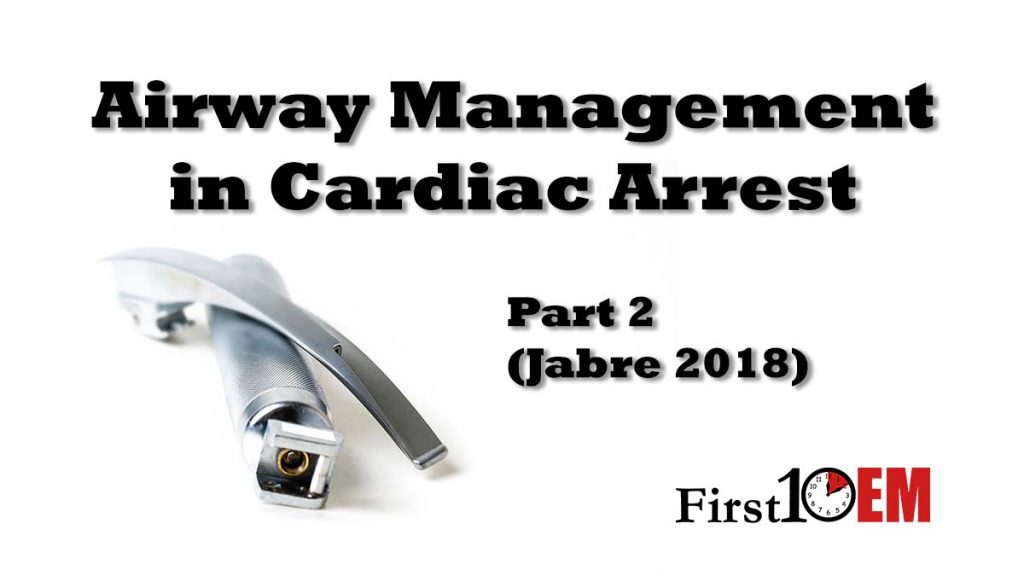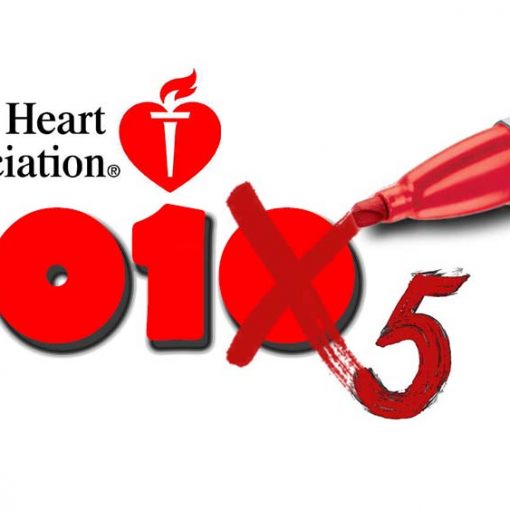Airway management is cardiac arrest is always a hot topic of debate. Yesterday we looked at AIRWAYS2, demonstrating no difference in survival with good neurologic outcomes between a laryngeal mask airway and intubation. (Benger 2018) However, those are both advanced interventions. Are either required? Where does the mighty bag valve mask fit in? Today we tackle the second paper in our series of 3, comparing BVM to intubation in out of hospital cardiac arrest.
The rest of the series:
The paper
Jabre P, Penaloza A, Pinero D, et al. Effect of Bag-Mask Ventilation vs Endotracheal Intubation During Cardiopulmonary Resuscitation on Neurological Outcome After Out-of-Hospital Cardiorespiratory Arrest: A Randomized Clinical Trial. JAMA. 2018; 319(8):779-787. PMID: [29486039]
The Methods
This is a randomized, parallel group, noninferiority, 2-country (Belgium and France), multicenter trial comparing the efficacy of BMV vs endotracheal intubation in patients with out of hospital cardiac arrest. (Jabre 2018)
Patients: Adults aged 18 years or older with out-of-hospital cardiac arrest.
- Patients were excluded if there was suspected massive aspiration before resuscitation, the presence of a DNR, known pregnancy, or imprisonment.
Intervention: Initial ventilation using a BVM during CPR.
Comparison: Endotracheal intubation.
- Crossover between the groups was allowed (if BVM was impossible, intubation was an appropriate rescue procedure, and if intubation was difficult or impossible, BVM was allowed, as were other rescue options such as LMA and video laryngoscopy.)
- If there was ROSC, the patient was intubated in the field, whichever group they were assigned to.
Outcome: The primary outcome was 28 day survival with good neurologic outcome (Glasgow-Pittsburgh CPC or 2 or less).
- This was a non-inferiority trial. In order to be considered non-inferior, the difference between the groups (including the 95% confidence interval) had to be less than 1%. Intubation was assumed to be the standard care group.
- Outcome assessors were blinded, but obviously clinicians were not.
The Results
For the primary outcome of neurologically intact survival at 28 days, there was no difference between the groups (4.3% vs 4.2%, 1 sided 95% CI 1.64% – infinity). However, because the 95% confidence interval extended beyond a 1% difference between the groups, their conclusion is that they failed to demonstrate the noninferiority of BVM. (I know, the language of noninferiority trials is weird.)
Secondary outcomes:
- ROSC higher with intubation (38.9% vs 34.2%, 95%CI -8.8% to -0.5%, p=0.03).
- No difference in survival to hospital admission (28.9% vs 32.6%).
- No difference in 28 day survival (5.4% vs 5.3%).
- No difference in the per-protocol analysis.
Adverse events:
- Airway management difficulty was more common in the BVM group (18.1% vs 13.4%, ARR 4.7%, 95% CI 1.5% to 7.9%, p=0.004).
- Airway failure was more common in the BVM group (6.7% vs 2.1%).
- Regurgitation was more common in the BVM group (15.2% vs 7.5%).
- Esophageal intubation was recognized in 10% of the intubation group. They say that there were no unrecognized esophageal intubations, but that would clash with the meaning of unrecognized.
My thoughts
This is a good study, focused on an important issue, with the best possible primary outcome, but unfortunately various methodological issues will probably leave us with more questions than answers. (Jabre 2018) The study is unblinded, which always produces significant potential for bias. The EMS services studied included physicians, which limits external validity to EMS systems in North America. However, the skill level of individual providers isn’t discussed, and airway experience could be a major confounder.
This was a negative trial, but there were more adverse events in the BVM groups. I am not sure that those adverse events actually matter, though, if neurologically intact survival is unchanged. (One of the major reasons people want to intubate is to prevent regurgitation. However, there is observational data that indicates that ⅔ of cardiac arrest patient have regurgitated before EMS arrives, and ⅔ of cardiac arrest patients consistently develop pneumonia, whatever the initial airway plan. I can’t find these studies right now. If you know the citation, let me know so I can add it.)
Non-inferiority statistics can be confusing. My solution: ignore them. The outcome between the two groups was clearly the same. Just look at the numbers. One of my big problems (among many) with non-inferiority trials is that you have to make a huge assumption right at the outset based on which intervention you decide is standard care. Prior observational research has suggested that intubation is associated with worse outcomes than BVM. Therefore, I would have set the trial up assuming the BVM is the baseline, and asked whether intubation is non-inferior. They chose to do the opposite, which biases in favour of intubation.
Another big issue is the crossover of patients between the groups. Although the per protocol analysis showed the same results, the per protocol analysis essentially turns this into an observational study. Why did clinicians decide to abandon BVM in some patients and not others?
Ultimately, whether this study provides you with valuable information depends a lot on the question you are trying to ask. When I am managing a cardiac arrest, it is never a black and white decision between BVM and intubation. I will start with one, but can change my approach if I run into difficulties, much like they did in this study. Therefore, if you are just asking which technique you should start with, this pragmatic, unblinded design with crossover between the groups is reasonable (and tells us either option is fine).
However, the implications are far less clear if you are an EMS agency trying to decide whether to train paramedics in advanced airway skills. This isn’t a pure BVM vs intubation study. It is a study of which option to use first (in the hands of physician led EMS crews). Taking away the backup option could have significantly altered the results. Therefore, I don’t think it is fair to conclude that prehospital intubation should be abandoned based on these results, although it might be fair to question whether there was ever sufficient data to start intubating people in the field.
One tangential point that really bugs me: they didn’t mention capnography anywhere in this manuscript. To me this is an essential airway tool. How quickly were their esophageal intubations discovered (which happened 10% of the time)? More importantly, how were they sure they were delivering breaths with the BVM? Waveform capnography, in my mind, is essential in cardiac arrest management, whatever your primary airway plan is.
Another tangent: because of the pragmatic nature of the 3 trials covered this week, none of them give us information about chest compression quality. This is a potential major confounder in the data.
Bottom line
In this study, bag valve mask resulted in equivalent neurologically intact survival to intubation. (Jabre 2018) If BVM is going well, there is little reason to change. However, there was a reasonably high rate of difficulties with BVM, and in those cases an alternative option should be employed. My main problem with a BVM approach is a lack of trust. As the team lead, it is hard to monitor if a good seal is being maintained. Waveform capnography eliminates that concern, but I still tend to favour the LMA over BVM because it is easier.
Other FOAMed
Jabre 2018 discussed in: The Last Gap – Taming the SRU
For more discussion of airway issues, see my 5 part airway management series here.
References
Benger JR, Kirby K, Black S, et al. Effect of a Strategy of a Supraglottic Airway Device vs Tracheal Intubation During Out-of-Hospital Cardiac Arrest on Functional Outcome: The AIRWAYS-2 Randomized Clinical Trial. JAMA. 2018; 320(8):779-791.
Jabre P, Penaloza A, Pinero D, et al. Effect of Bag-Mask Ventilation vs Endotracheal Intubation During Cardiopulmonary Resuscitation on Neurological Outcome After Out-of-Hospital Cardiorespiratory Arrest: A Randomized Clinical Trial. JAMA. 2018; 319(8):779-787. (Jabre 2018)
Wang HE, Schmicker RH, Daya MR, et al. Effect of a Strategy of Initial Laryngeal Tube Insertion vs Endotracheal Intubation on 72-Hour Survival in Adults With Out-of-Hospital Cardiac Arrest: A Randomized Clinical Trial. JAMA.
Morgenstern, J. Airway management in cardiac arrest part 2 (Jabre 2018), First10EM,
November 20, 2018. Available at:
https://doi.org/10.51684/FIRS.6529







2 thoughts on “Airway management in cardiac arrest part 2 (Jabre 2018)”